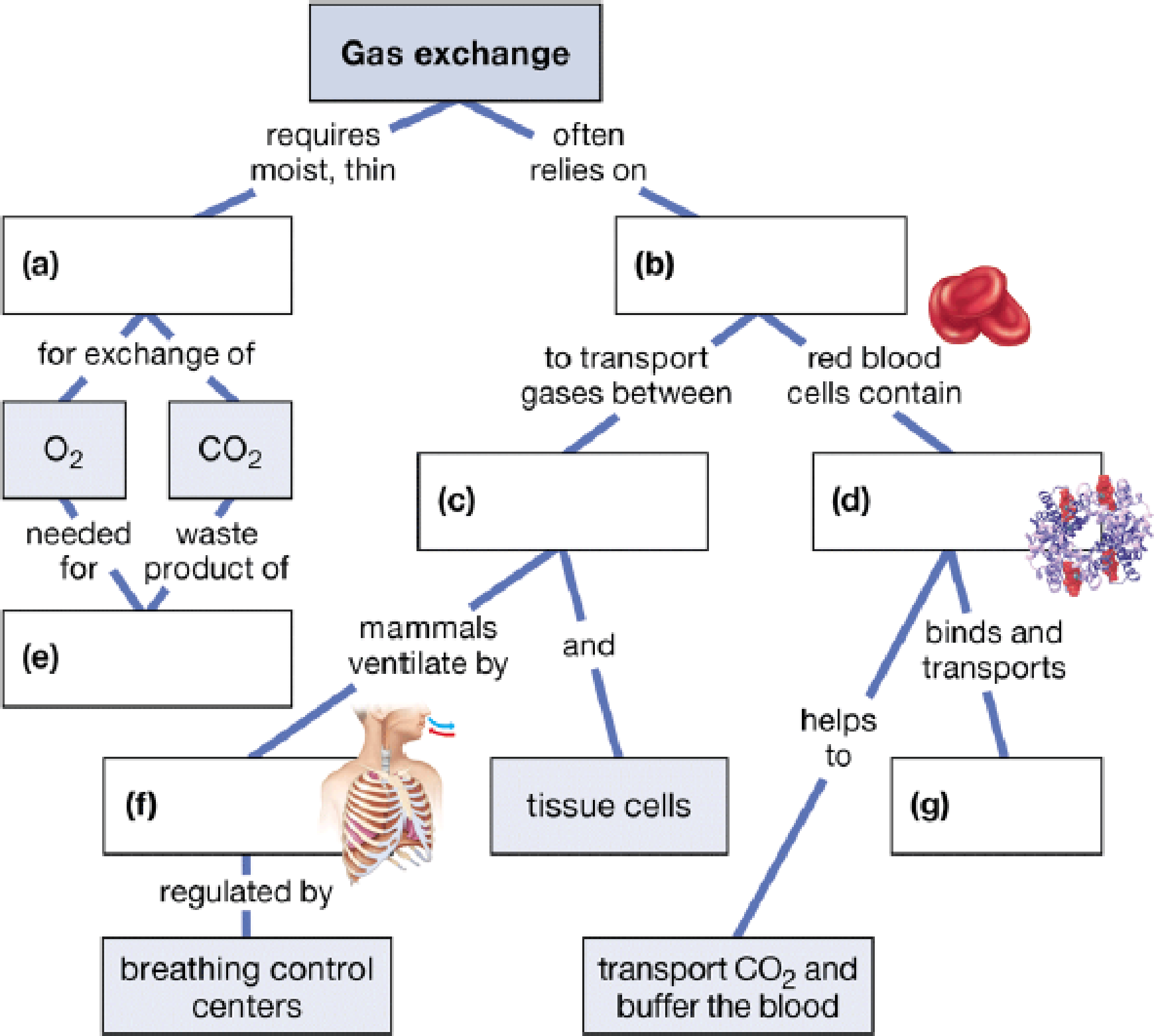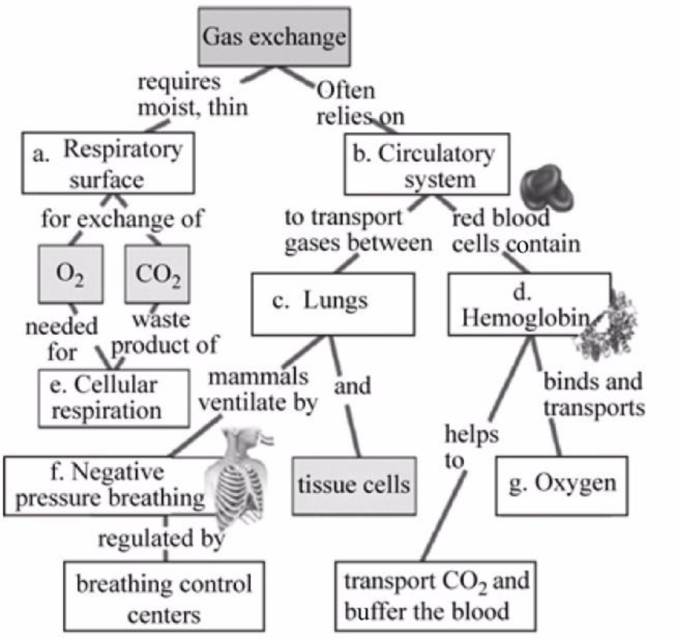
Concept explainers
Complete the following concept map to review some of the concepts of gas exchange.

To complete: The given map to review some of the concepts of gas exchange.
Introduction:
The respiratory system is a biological system that ensures the transport of air by the process of inhalation and exhalation, that is, in and out the body with the help of the lungs.
Answer to Problem 1CC
Fig.1 shows the completed map to review some of the concepts of gas exchange.
Pictorial representation: Some of the concepts related to gas exchange are presented in the concept map given in Fig.1.

Fig.1: Concepts of gas exchange.
Explanation of Solution
a.
Correct answer: Respiratory surface.
For gas exchange to occur, the respiratory surface should be thin and moist. Hence, the correct answer is the respiratory surface.
b.
Correct answer: Circulatory system.
Gas exchange relies on the circulatory system as the exchanged oxygen and carbon dioxide travel in the blood to the heart and different body cells. Hence, the correct answer is the circulatory system.
c.
Correct answer: Lungs
It is the main organ for the exchange of gases consisting of air sacs that carry out gaseous exchange and the blood carries the exchanged gas to the tissue cells. Hence, the correct answer is the lungs.
d.
Correct answer: Hemoglobin.
Hemoglobin is a blood pigment present inside the red blood cell, which helps in the transport of oxygen and carbon dioxide by binding with it and also maintains the pH of the blood. Hence, the correct answer is hemoglobin.
e.
Correct answer: Cellular respiration.
In cellular respiration, oxygen is used to convert glucose into carbon dioxide, water, and energy in the form of ATP. Hence, the correct answer is cellular respiration.
f.
Correct answer: Negative pressure breathing.
This type of breathing is regulated by the “breathing control center of the brain”. In negative pressure breathing, the air pressure inside the lungs drops during the contraction of the diaphragm, and the lower portion of the chest cavity rises; this allows the movement of air from outside to inside. Hence, the correct answer is negative pressure breathing.
g.
Correct answer: Oxygen.
Hemoglobin pigment in the blood binds with the oxygen present in the lungs, and this oxygen is utilized to form energy. Hence, the correct answer is oxygen.
Want to see more full solutions like this?
Chapter 22 Solutions
Campbell Biology Concepts and Connections, Third custom edition for Orange Coast College, Includes Online Access code.
- Briefly state the physical meaning of the electrocapillary equation (Lippman equation).arrow_forwardExplain in a small summary how: What genetic information can be obtained from a Punnet square? What genetic information cannot be determined from a Punnet square? Why might a Punnet Square be beneficial to understanding genetics/inheritance?arrow_forwardIn a small summary write down:arrow_forward
- Not part of a graded assignment, from a past midtermarrow_forwardNoggin mutation: The mouse, one of the phenotypic consequences of Noggin mutationis mispatterning of the spinal cord, in the posterior region of the mouse embryo, suchthat in the hindlimb region the more ventral fates are lost, and the dorsal Pax3 domain isexpanded. (this experiment is not in the lectures).a. Hypothesis for why: What would be your hypothesis for why the ventral fatesare lost and dorsal fates expanded? Include in your answer the words notochord,BMP, SHH and either (or both of) surface ectoderm or lateral plate mesodermarrow_forwardNot part of a graded assignment, from a past midtermarrow_forward
- Basic Clinical Lab Competencies for Respiratory C...NursingISBN:9781285244662Author:WhitePublisher:Cengage
 Anatomy & PhysiologyBiologyISBN:9781938168130Author:Kelly A. Young, James A. Wise, Peter DeSaix, Dean H. Kruse, Brandon Poe, Eddie Johnson, Jody E. Johnson, Oksana Korol, J. Gordon Betts, Mark WomblePublisher:OpenStax College
Anatomy & PhysiologyBiologyISBN:9781938168130Author:Kelly A. Young, James A. Wise, Peter DeSaix, Dean H. Kruse, Brandon Poe, Eddie Johnson, Jody E. Johnson, Oksana Korol, J. Gordon Betts, Mark WomblePublisher:OpenStax College





